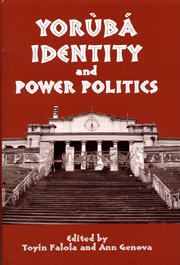Book contents
- Frontmatter
- Contents
- List of Illustrations
- Introduction
- Part I Writing Yorùbá
- 1 The Yorùbá Nation
- 2 Oral Tradition and the Reconstruction of Yorùbá Dress
- 3 Diaries as Cultural and Intellectual Histories
- 4 Historiography of Western Yorùbá Borderlands
- 5 The History of the Okun Yorùbá: Research Directions
- 6 Ìlá Kingdom Revisited: Recent Archaeological Research at Ìlá-Yàrà
- 7 Early Ìjѐbú History: An Analysis on Demographic Evolution and State Formation
- Part II Chiefs and Tradition
- Part III Identity and Modern Politics
- Notes on the Contributors
- Index
2 - Oral Tradition and the Reconstruction of Yorùbá Dress
from Part I - Writing Yorùbá
Published online by Cambridge University Press: 12 September 2012
- Frontmatter
- Contents
- List of Illustrations
- Introduction
- Part I Writing Yorùbá
- 1 The Yorùbá Nation
- 2 Oral Tradition and the Reconstruction of Yorùbá Dress
- 3 Diaries as Cultural and Intellectual Histories
- 4 Historiography of Western Yorùbá Borderlands
- 5 The History of the Okun Yorùbá: Research Directions
- 6 Ìlá Kingdom Revisited: Recent Archaeological Research at Ìlá-Yàrà
- 7 Early Ìjѐbú History: An Analysis on Demographic Evolution and State Formation
- Part II Chiefs and Tradition
- Part III Identity and Modern Politics
- Notes on the Contributors
- Index
Summary
Dress as a human body covering is significant in the daily life of man worldwide. The study of dress generally has received attention from archaeologists, anthropologists, art historians, economic historians, home economists, and physical and chemical scientists, among others. Despite the favorable response to its study, not much is known about the pre-twentieth century period of its form, use, and production in many African communities. For example, little is known about the pre-twentieth century Yorùbá dress traditions beyond glimpses from travelogues. This has created a lacuna in the study of Yorùbá history and culture. Filling this gap has involved, for example, the use of varying approaches such as the perspective of studying the dress modes of succeeding generations of families from their photograph albums. The other way was the exploration of eyewitness accounts. The short time span covered by these approaches poses some limitations, which are rectified by the use of oral tradition.
Oral history, otherwise known as ìtàn in Yorùbá (collective name for myths, legends, and traditional history), makes copious references to events that occurred many centuries ago without providing any reference to absolute dates. Another positive side is that many ìtàn provide stories of origins on varying subjects. Those on dress history reflect clothing traditions, beliefs, habits, laws, and values, as well as providing hindsight as to how some contemporary dress modes emanated from the distant past.
- Type
- Chapter
- Information
- Yorùbá Identity and Power Politics , pp. 49 - 73Publisher: Boydell & BrewerPrint publication year: 2006



